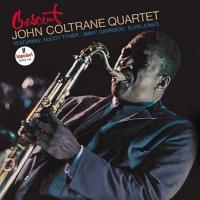John Coltrane Quartet's Crescent Reissued by Verve/Acoustic Sounds
The album of all Coltrane originals featuring the “classic quartet” begins with a pair of low-key, contemplative ballads: the title tune and “Wise One”, which in its midsection spotlights McCoy Tyner’s deep grooved explorations after which Coltrane enters with an expressive melt your mind melodic turn. The tune comes to a slow dramatic conclusion anchored by Garrison and Jones. An album highlight aided by RVG’s closely mic’d recording that gets everything right.
The side ends with “Bessie’s Blues” a short swinging toe tapper that would sound as at home in a club as on record.
Side two opens with “Lonnie’s Lament”, a bucket full of somber regret ripe for inclusion for a movie soundtrack. Garrison’s nifty solo is a highlight, after which the group returns to the somber regret heard at the beginning. A live version of this tune was recorded in Europe in 1962 before the studio date but not released until 1977 on Afro Blue Impressions (Pablo 2620 101) a double LP set you could pick up at one time for a song (or maybe even just a riff). In the notes Norman Granz writes that even before a mid-50s session at which Johnny Hodges brought along Coltrane, he was “playing rock and roll.” This twofer is not costly if you can find one (about $30 on Discogs) and the sound is surprisingly good though the stereo may be “fake”. Fortunately, it’s moderately and tastefully applied reverb that in no way detracts from great playing and programming.
“The Drum Thing” obviously is a vehicle for Elvin Jones but don’t worry, it’s not a grandiose splashy solo-laden showcase. The vehicle is more a boat ride through the Amazon.
At the end of the year that produced Crescent mid-year, Coltrane entered Van Gelder’s Englewood Cliffs Studio and recorded A Love Supreme released less than a month later in early 1965. The inner gatefold photo here was again used on A Love Supreme’s cover.
Ryan Smith has done a masterful job (no pun intended) with what again sounds like a master tape copy (unless the original tape has just lost some top end) at least based on a “top end” comparison where on the original Coltrane’s sax has greater “presence” texture and air and Jones’s drum kit more natural sizzle—as well as there being more “room air”— but it’s also easy to make a case for far better bass and piano presentation on the reissue. Rudy’s original sounds as if he’s rolled off the bottom and done a bit of compression. Overall if forced to choose one, I’m not sure I’d take the original over the new reissue, though I’m not selling the original (mine’s a second label, red/black, but otherwise a first pressing). That’s how good this is.



